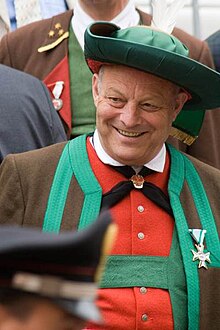Landeshauptmann

Landeshauptmann (German for "state captain" or "state governor", plural Landeshauptmänner or Landeshauptleute), female form: Landeshauptfrau, is the gubernatorial title of the head of government of an Austrian state and the Italian autonomous provinces of South Tyrol and Trentino, corresponding to the title of minister-president or premier. Until 1933 the term was used in Prussia for the head of government of a province,[1] in the modern-day states of Germany the counterpart to Landeshauptmann (state governor) is here the Ministerpräsident (minister-president).
Origins
Since the early modern period, a Landeshauptmann originally served as a gubernator of a Prince of the Holy Roman Empire or of the Emperor himself, mainly in the territories of the Habsburg Monarchy (as for the Lands of the Bohemian Crown), later also in the Kingdom of Prussia. In the Austrian Empire, according to the 1861 February Patent, the title referred to the president of the Landtag assembly of a Habsburg crown land (called Landmarschall[disambiguation needed] in Lower Austria, Bohemia, and Galicia), who also served as head of the provincial administration. The Imperial-Royal government in Vienna was represented by a Statthalter or Landespräsident governor.
With the dissolution of Austria-Hungary and the proclamation of the Republic of German-Austria in 1918, provisional state assemblies and state governments were established, headed by a Landeshauptmann. The 1920 constitution of the First Austrian Republic (Bundes-Verfassungsgesetz) unified the office of a Federal Government representative and head of the state government. The title is today used in modern Austria as well as in South Tyrol and Trentino, autonomous provinces in Italy with strong linguistic and cultural ties to the neighbouring Austrian state of Tyrol. In the Czech Republic, a hejtman (German: Hauptmann) represents each of the 13 self-governing regions (Czech kraj, pl. kraje). The title was also used by the German Empire for governors during the early stages of its colonial rule over South West Africa (1893–1898), Togoland (1893–1898) and German New Guinea (1886–1889, 1892–1899).
Austria
In modern Austria, the title is used for the head of the executive of the nine Austrian states, equivalent to the position of a Ministerpräsident in German states. The Landeshauptmann is elected by the Landtag state parliament of the respective state and sworn in by the President of Austria. As representative of the federated state on state level he is also responsible for the enforcement of federal laws.
The Mayor of Vienna also serves as a Landeshauptmann, elected by the municipal assembly (Wiener Gemeiderat und Landtag). When Waltraud Klasnic (ÖVP) became state governor of Styria in 1996, she peferred to be addressed as Frau Landeshauptmann, whereas Gabi Burgstaller (SPÖ), state governor of Salzburg from 2004 to 2013, preferred Frau Landeshauptfrau. Since 1 July 1988, the Constitution of Austria allows for, but does not prescribe, office designations to be gender-specific [2]
South Tyrol and Trentino
According to the 1946 Gruber–De Gasperi Agreement and the Second Autonomy Statute of 1972, the chief executives of the provincial governments (Template:Lang-it) of South Tyrol and Trentino are called Landeshauptleute in German.
The head of government of South Tyrol is elected by the provincial Landtag legislature. The Landeshauptmann represents the province to the outside and in meetings of the regions with the Italian government. He is also entitled to attend the sessions of the Council of Ministers as far as South Tyrolean issues are discussed. His two deputies have to represent the Italian and German language group.
Despite the German terms Landeshauptmann and Landtag, South Tyrol and Trentino according to Italian conception are no federated states (Länder) but merely subnational administrative divisions (enti territoriali), though with considerable self-government responsibilities and legislative powers.
Prussia
From 1875 the territorial authority of the estates in the twelve administrative provinces of Prussia were re-organised as Provinzialverbände. Each of these self-governing bodies were represented in a Provinziallandtag assembly, whose members were delegated by the rural and urban districts within the province. The districts organised through their elected deputees their utilities, such as construction and maintenance of provincial roads, hospitals, schools, public savings banks, waste disposal etc., in self-rule.
The provincial administration was initially headed by a Landesdirektor, who was elected by the assembly for six-year terms (in Pomerania: five years) and maximally two terms. The holder of the office presided over the Provinzialausschuss, i.e. provincial government of self-rule, whereas the Oberpräsident was the king-appointed representative for the province, busy with implementing and supervising central prerogatives of the Prussian government.
In the following decades, Landeshauptmann gradually replaced the earlier expression Landesdirektor in all but one of Prussia's provinces. When the kingdom turned into a free state in 1920, only the Landtag of Brandenburg had decided to keep the traditional expression.[3] With the abolition of democratic self-rule on all government levels in the course of the Gleichschaltung process after the Nazi takeover in 1933, the office-holders were furloughed or retired and the offices remained vacant.
Klaipėda Region
The Klaipėda Region (Template:Lang-de), which was dissected from East Prussia after World War I and annexed by Lithuania in the Klaipėda Revolt of 1923, continued the usage of the terms Landesdirektor (i.e. government member) and Landesdirektorium (Template:Lang-lt; i.e. government). The head of government was given the title Landespräsident (state president).
